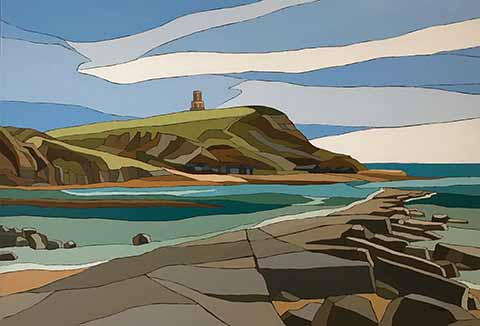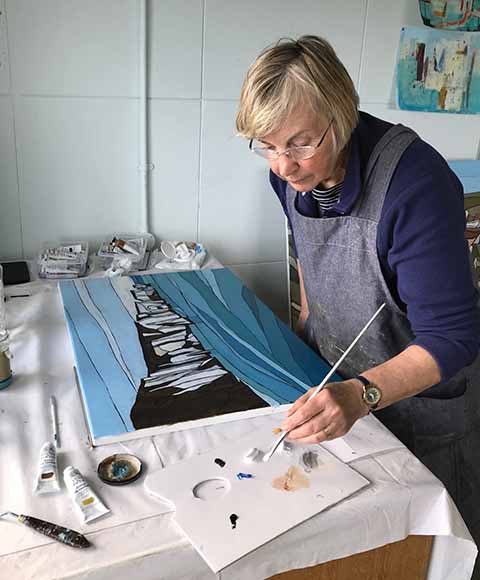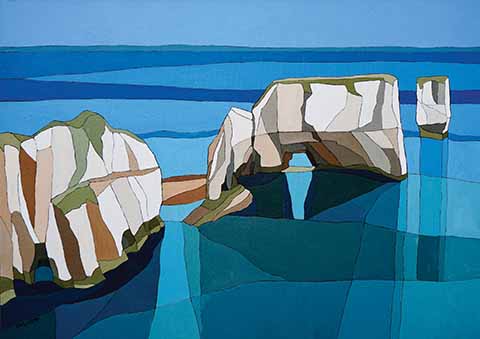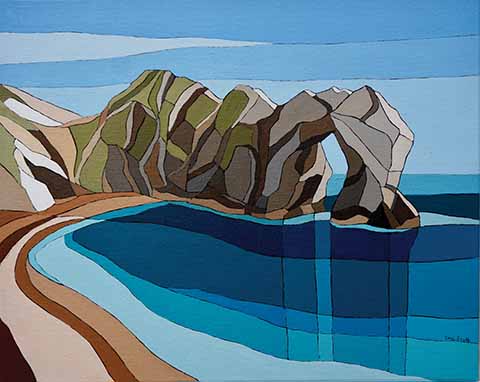Dorset artist – ‘Where land meets sea’
Tim Saunders talks to Dorset landscape artist Caz Scott
Published in January ’19
Walking the well-trodden coastal path from Studland to Golden Cap provides the inspiration for Caz Scott’s distinctive paintings of the Jurassic Coast. To be able to successfully combine passions for hiking and painting and to make these generate an income is the stuff of dreams for many. It has not happened overnight though; this is the culmination of 40 years’ work.
Her stylised paintings with a limited palette caught the attention of the then franchise holder, South West Trains, which commissioned her Durdle Door artwork to be applied externally to four train carriages across the network, including those running from Weymouth to London Waterloo. The aim was to cheer up depressed commuters, according to Emma Wiles from South West Trains: ‘We wanted to brighten up the dullest of winter days by bringing a burst of summer colour to stations.’
Caz’s paintings are, she says, about ‘shedding light on the landscape, its strength and structure’. She fell in love with the area during regular trips to the Isle of Purbeck to study its geology in the 1970s and has been living here for more than twenty years: ‘Dorset is the place where the world really comes alive for me. It’s so exciting and inspirational, thanks to the rock formations and fossils,’ she says. ‘Purbeck is an amazing landscape, with so many distinctive features within such a small area. I have always been drawn to this landscape and to the coast – the light, the space, the point where land meets sea, exposing the amazing rock structures. The Jurassic Coast is hugely inspirational with its magnificent landforms and breathtaking views across this wonderful ancient landscape.’
From a geological perspective, the coastal landscape has extraordinary diversity resulting from unique rock structures that have been exposed through natural processes and are constantly being eroded and reshaped. According to Caz: ‘The coastal path constantly brings new and breathtaking views of cliffs and bays and wide soaring skies, which are irresistible to an artist. I love the geology, shape, colour and light.
‘The cliffs here are some of the most spectacular in England,’ says Caz. ‘They are of great geological interest, for both the rock types and the variety of landforms, notably Lulworth Cove and Durdle Door. Each time I re-visit familiar places I feel a new frisson of excitement.’
The scenery constantly lifts her spirits and she is driven to paint to reflect the strength and harmony of this irresistible ancient landscape: ‘I marvel at how that rugged landscape has been shaped,’ she says. ‘Five hundred million years of history, such massive changes, yet the result looks and feels so permanent and unchanging. But we know it will eventually all disappear and re-form and re-shape. There at the edge I can see so clearly, the light takes on a different quality. When I look at the coast, I see everything is perfectly placed, nothing untidy, no jarring notes, great harmony. I can’t improve it, I only aim to reflect. I want my audience to look nearly as hard as I do when I’m out drawing.’
The Dorchester-based painter always has her sketchbook to hand and concentrates on specific views that catch her eye. ‘Often it can be a response to the weather, the light and shadows, the seasons, the structure of the land or the intensity of the vegetation’. Her love of walking, which has a huge impact on her work, cannot be understated. ‘I often re-visit favourite views and make new drawings for every new painting. I find this keeps my work fresh and I always find new details. I paint in oils, usually on canvas.’
Caz’s paintings are literal. The canvases are flat, with no texture. ‘I always work from a dark canvas – raw umber. Composition is vital and I draw out my image in charcoal. Then I place the paint and it immediately glows and shimmers. It’s hard to change if it’s not right. Minor adjustments are acceptable, but sometimes I have to abandon work, even near completion, because it’s simply not right.’
Future plans include refining her palette further still, experimenting more and ‘maybe moving towards greater abstraction while also exploring new landscapes with fresh views’.
Studying drawing and sculpture at Bournemouth Arts University, Caz decided to focus on painting but is beginning to work in clay once again. She exhibits widely, including at the Etches Collection Museum of Jurassic Marine Life in Kimmeridge. In May 2019 she will open her Dorchester studio. The following month Caz will show her work at Durlston in Swanage. She will then be at Eype and is planning exhibitions for 2020.
www.caz-scott.co.uk






